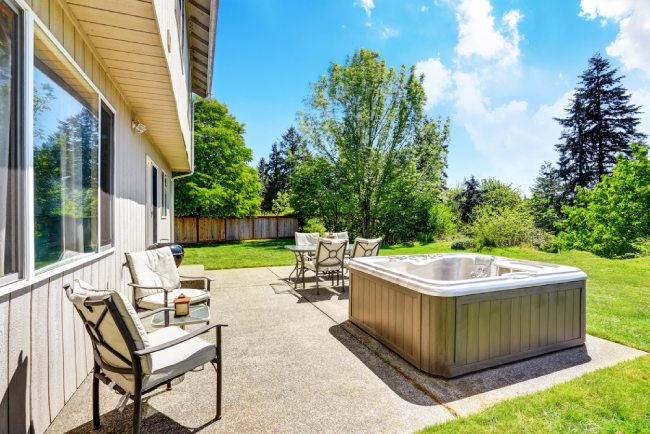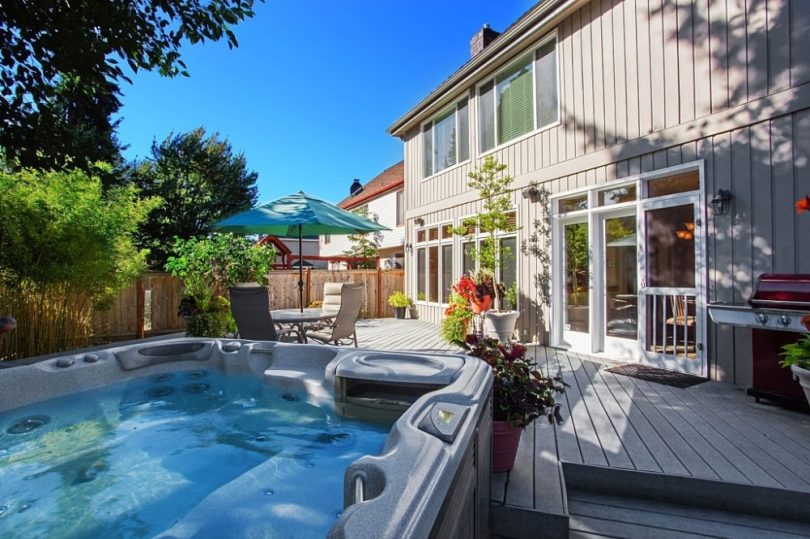Place your hot tub about 15 to 20 feet away from overhead power lines to minimize the danger of electrocution and no less than 2 yards away from your home walls or out-built structures to prevent any possible flooding.
Another idea is nearby a gateway to the house or a changing space for the winter.
Table of Contents
How Close Can a Hot Tub Be to a House? – Key Factors to Consider
1. Access to electricity and water sources
Having safe, reliable electricity and water sources close to your tub is super important. In case you don’t have electricity nearby, expect some extra expenses coming your way to power up from afar.
2. Current backyard layout
The location of your hot tub greatly depends on the present setup and layout of your backyard.
If you have swimming pools, decks, gazebos and patios in your backyards, you may not find it easy to move or revamp them to make way for your hot tub.
3. Personal preferences
Your personal preferences have the most impact here. Of course, you’ll do all things necessary once you’ve made up your mind about the location you see fit.
4. Drainage facility
You should have a proper drainage system, which can handle hundreds of gallons of water at a time. If your tub is located too near your house, you may face flooding problems in your house during the drainage of your tub. Additionally, Heavy splashing over a long time can also be a problem.
The system has to drive away water from your house properly. Make sure the tub isn’t too close to your house and has a proper drainage facility
5. Overhead situation
Your tub can be highly contaminated with unwanted objects if it has an overflowing or leaking eavestrough system or an overhanging roof over it. It can cause your hot tub water to need frequent replacing or heavy chemicals for sanitization.
In the winter season, it is highly possible to get disturbed or even injured by falling snow or icicles from the roof or eavestrough.
It is also recommended not to place your tub under any type of wiring, especially electric wires.
6. Other things to consider
- Location of the lighting on the way to the tub is important to safety and convenience
- The ground condition also has to be considered as tubs should be on a tough and level grounds
- Privacy should also be prioritized if you don’t want your neighbors to see you or your family members in awkward situations
What to Get Through Before Outdoor Hot Tub Installation?
-
Building permit
You’re required to get a permit for exterior construction and electrical circuits in most cities and counties.
It’s a good idea to talk to a local building official to check the standpoint of your city or county regarding the matter. It’s likely that you’ll be asked about the location, base, and wiring.
-
Fence or gate around your tub
Some communities maintain codes for the residential barriers such as self-closing gates or fences on the property to control any unsupervised entrance to hot tubs by children below five years of age.
Take a look at your local building codes to decide whether you need a fence or gate around your tub or not.
-
Plumbing
Surprisingly, hot tubs are self-contained and no plumbing work is needed. You can fill your new unit entirely with a garden hose and blank it with a siphon or a motor pump.
But call in a plumber if your tub is an old and defected one.
-
Electrician
You’ll need to appoint a certified electrician for installing your hot tub to avoid the dangers. Trying a DIY set up would be unwise since hot tubs are run on Ground Fault Circuit Interrupter (GFCI) (120v, 220v, or 240v with a 40 to 50-amp circuit).
Most GFCI circuits come with a built-in breaker with the ability to halt electrical current straight away the moment H2O makes contact with the involved devices.
In most cases, your tub should be hard-wired throughout the floors and sidewalls into the control pack. The GFCI is installed on an extrinsic wall minimum 5 feet away from the spa unit.
Don’t forget to double-check all the electrical work before you start pouring water into your spa.
When is it too close?
Placing your hot tub right next to the door, window, wall of your home, or walkway might be too close. Try to balance between convenience and privacy before you finalize the location.
Sensibly think of the amount of space you comfortably need for people to pass through the entrance without the hot tub getting in the way.
Consider the situation when groceries and over-sized deliveries need to be carried in — would there be plenty of room to pass by the tub?
Outdoor Hot Tub Placement: In-Depth Analysis

1. A good foundation
Be sure to consider the weight of the tub filled with water and people before you pick the foundation. The ideal outdoor hot tub placements include composite or wooden decks, masonry or brick patios, and custom structures such as gazebos and gravel pads.
You can place your tub on every type of solid, level, and uniform surface but you should not place it on bare ground or grass to protect it from damage.
2. Electrical setup
In the United States, your hot tub’s electrical wiring must meet the NEC (National Electric Code) requirements and relevant local codes. The electrical circuit should be installed by a technician certified by a local inspector.
You need to get some of the drilling and electrical wiring done even before the hot tub is up in place such as copper tech wiring and attaching the spa pack to the house wall.
3. Weather
Weather is a big concern when it comes to your hot tub placement. Do keep your tub reasonably close to an external door for swift access if you live in a state with snowy cold winters and pretty hot summers.
Consider placing your tub near trees, patio cover, shrubs, hot tub umbrella, or under a gazebo as you may need shade from the hot sun.
4. Privacy
Take notes of the surroundings of the tub (fences, shrubs, trees) during the courses of each season and decide on your privacy. Keep your neighbor’s view in mind and accordingly plan the best location.
5. View
Hot tubs are among the luxuries of life. Select a special place that offers the best views when you take a soak after a long day at work.
Facing the exterior walls of your house may not be much of an enjoyable sight. Select a place where you’ll be confronted, for instance, the flowering shrubs in your yard or a pretty twilight sky.
6. Hygiene
Pay attention to important details like the position of trees or the spill routes from guttering, so you have a clear look at the possibility of dirt, debris, and foliage getting easily swept into your tub by wind or rain.
Popular Types of Hot Tub Foundations
-
Concrete
A concrete cement pad could be your quick and easy solution but it should not be less than 4 inches thick.
-
Spa pads
These are interlocking pads for bedding on grass, bare ground, and are sturdy but moveable foundations. You may choose one for a short-term situation like in a rental house.
-
Concrete pavers
Concrete pavers are a better choice compared to stone patio pavers for your hot tub foundation since they’re interlocking pavers.
Form your pad under the supervision of a structural engineer or contractor and get your tub finely level and balanced.
Why Do You Need to Shade Your Outdoor Hot Tub?
A shade above will protect you and your tub from the ravages of the sun. The heat coming from the deflection of your windows and other reflective vertical surfaces can be damaging to your tub’s casing.
Trees may provide natural shading, but I’m sure you don’t want to see any twigs and leaves in your tub. You can shade your hot tub in many ways; with a gazebo, awning, pergola, or even a hot tub umbrella.
FAQs
1. How much space is needed around a hot tub?
Ans. Leaving at least a foot of free space around each side is a good rule of thumb. You’ll need that extra area for things like removing the cover.
2. Can Neighbors complain about hot tubs?
Ans. Yes, they may complain about the noise your hot tub makes when you turn on the jets and stuff. Check if they’re happy for you before the tub causes friction between you and your neighbors.
3. Can I put a hot tub in my garage?
Ans. Yes, if you can ensure water availability, enough space, safe power supply, appropriate drainage and such things in your garage. In fact, a hot tub in your garage is fine since the tub is protected from the extreme outside conditions.
Have a good ventilation system in your garage, so you don’t spoil the interior from the heavy stream and moisture build-ups.








Leave a Comment